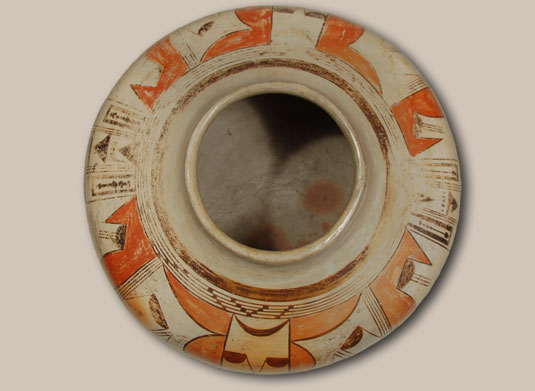Traditional Hopi Seed Jar by Nampeyo [SOLD]
+ Add to my watchlist Forward to Friend
- Category: Historic
- Origin: Hopi Pueblo, Hopituh Shi-nu-mu
- Medium: clay, pigment
- Size: 4-3/4” height x 10-3/8” diameter
- Item # C3732A SOLD
Nampeyo was an artistic genius who looked at fragments of ancestral Hopi ceramics from a thousand years ago and used that as her inspiration for creating shapes and designs on her pottery which she was making in the late 1800s and early 1900s. She rarely, if ever, copied designs from the Sikyatki but used those to create designs of her own.
This jar is one of Nampeyo’s creations using design inspiration from the Sikyatki potters before her. Any attempt to define the meaning of these designs would be purely speculative as only the potter from Sikyatki who first used similar ones would know if there was meaning or just personal creativity. The black design that separates the polychrome ones has been called eagle tail feathers but do we know who came up with that name? It seems like an obvious description and certainly will continue to be used in the future. Another design has been interpreted as a Katsina face. The two half circle eyes would define the face and the pair of orange curved pieces could be horns.
It is not important to have meaning for each element in a design. The overall appearance, balance and flow is what should appeal to our visual senses. In this jar, those criteria are most evident and do fulfill the visual stimuli one anticipates.
The jar is probably an older one by Nampeyo. A potter of her artistic talent could be the only one who made such a jar. It has all the hallmarks of her hand. The jar was fired in a coal-burning atmosphere, contributing the ivory toned color to the jar’s surface and the polished inner lip of the rim. Such jars were featured prominently at the Fred Harvey Hopi House at the Grand Canyon in the early 1900s.
It is important to point out that the five concentric circles just below the rim were placed there with a paint brush made from the leaf of a yucca plant and they were painted on while the potter held the jar in her lap and rotated it free-hand as she continued painting the circle, then repeated it another four times. The preciseness of the placement of those lines is an indication of a talented artist mastering the techniques of using primitive tools in a primitive manner.
Condition: a hairline crack runs vertically from the rim down about 1 inch. Some of the design has been rubbed off but that adds to the patina and beauty of the jar.
Recommended Reading: Canvas of Clay: Seven Centuries of Hopi Ceramic Art by Edwin L. Wade and Allan Cooke
Provenance: from a client who inherited this from her dad and who is now moving to a new home in Florida and chose not to take a chance on moving the pottery too.

- Category: Historic
- Origin: Hopi Pueblo, Hopituh Shi-nu-mu
- Medium: clay, pigment
- Size: 4-3/4” height x 10-3/8” diameter
- Item # C3732A SOLD



